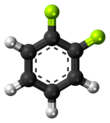1,2-Difluorobenzene, also known as DFB, is an aromatic compound with formula C6H4F2. This colorless flammable liquid is a solvent used in the electrochemical studies of transition metal complexes. Compared to most conventional halogenated aliphatic and aromatic solvents, it possesses an exceptionally high dielectric constant (ε0 = 13.8 at 300 K). Thus, it can be a suitable solvent for cationic, and/or highly electrophilic organometallic complexes.[2]
| |||
| Names | |||
|---|---|---|---|
| Preferred IUPAC name 1,2-Difluorobenzene | |||
| Other names o-Difluorobenzene ortho-Difluorobenzene | |||
| Identifiers | |||
3D model (JSmol) | |||
| ChEBI | |||
| ChemSpider | |||
| ECHA InfoCard | 100.006.074 | ||
PubChem CID | |||
| UNII | |||
CompTox Dashboard (EPA) | |||
| |||
| |||
| Properties | |||
| C6H4F2 | |||
| Molar mass | 114.093 g/mol | ||
| Appearance | colorless liquid | ||
| Density | 1.1599 g/cm3 | ||
| Melting point | −34 °C (−29 °F; 239 K) | ||
| Boiling point | 92 °C (198 °F; 365 K) | ||
| (insoluble) 1.14 g/L | |||
| Related compounds | |||
Related compounds | 1,2-Dichlorobenzene | ||
Except where otherwise noted, data are given for materials in their standard state (at 25 °C [77 °F], 100 kPa). | |||
Synthesis
Difluorobenzenes can be prepared by the Balz-Schiemann reaction, which entails conversion of diazonium tetrafluoroborate salts to their fluorides. The synthesis of 1,2-difluorobenzene starts with 2-fluoroaniline:[3]
- C6H4F(NH2) + HNO2 + HBF4 → [C6H4F(N2)]BF4 + 2 H2O
- [C6H4F(N2)]BF4 → C6H4F2 + N2 + BF3
The syntheses of 1,3- and 1,4-difluorobenzene proceed respectively from 1,3- and 1,4-diaminobenzene, which are doubly diazotized.[4]
Laboratory applications
Organometallic derivatives of 1,2-difluorobenzene have been well developed. It is found to be a weaker base than benzene.[5]
1,2-Difluorobenzene has been used as solvent for the electrochemical analysis of transition metal complexes. It is relatively chemically inert, weakly coordinating and has a relatively high dielectric constant. It is a weakly coordinating for metal complexes, in contrast to acetonitrile, DMSO, and DMF.[6]
It has anaesthetic properties.[7]
1,2-Difluorobenzene can be acylated to 3',4'-difluoropropiophenone.[8]

